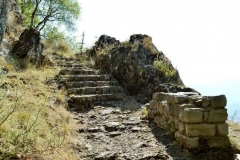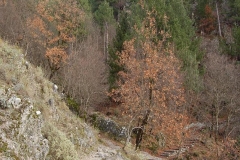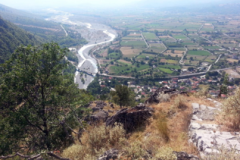The Castle of Konitsa is located in the east of the city, on top of a rocky and partly naturally fortified position, at the end of the ridge of Trapezitsa and a little above the picturesque chapel of Agia Varvara. The castle can be reached in about 30-45 minutes on foot from the city center. From there the view towards the valley and especially towards the gorge of Aoos and Mt. Tymfi is impressive. Following the stone-paved road to the house of Agios Paisios, a little further up we come across a hiking path that leads through a wonderful wooded path to the small church of Agia Varvara. Passing Agia Varvara there is a characteristic hollow in the ledge of an imposing rock and then on a wonderful route in the forest we ascend a stone-built path approaching the south-western part of the medieval castle. The view is panoramically magnificent as you look out over the entire area of the city of Konitsa, the gorge of the Aoos river, the imposing steep slopes of Tymfi, the peak of Gamila at 2497m, as well as the river bed of Aoos which meets Voidomatis in the background.
The castle guarded the entrance to the Aoos gorge and it is located on a hill at the western end of the Trapezitsa massif southeast of the town of Konitsa, on the north side of the Aoos gorge (information in the link).The path continues from the Castle and reaches the peaks of Trapezitsa at the location of Aiminadia.
Difficulty level: low. Route time: 30 minutes. Marking: sparse red markings. Altitude gradient: 470m- 720m
VENETIAN CASTLE
Pyrrhus the most important Molossian king (297-272 BC) expanded his territory and campaigned in Italy, aspiring to conquer Europe, like Alexander the Great did in Asia. Traces of the castles (that he built) are preserved in Artsista, Konitsa, Koutsoufliani, Mesogefyra and Fourka. Our province (called Livisda – 1336 AD) had financial transactions with the Venetians. The Venetians guarded the castle of Konitsa, which had been built and maintained during the reign of Justinian and since then served as a refuge for those who lived on the outskirts of the plain. For the guarding of these straits and passages, and above all for the prevention from the predatory Illyrian tribes Justinian built castles and settled old and tired veterans of his Roman legions who came from the surrounding areas. Remains of these castles (still preserved today) are also the Castle of Konitsa, the castle of Klidoniavista, Portes, and Reynikos.



















